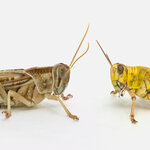Ecology & Zoology

Diversity police regulate success by making overachievers victims of their own success. They spread quickly, preventing too much dominance by undercutting whatever gets ahead and enforcing lots of mediocre equivalence. They're pests.
The pests we're talking about are, of course, fungi in rainforests. They play a crucial role in biodiversity by spreading quickly between closely-packed plants of the same species - the success of these fungal diversity police makes sure nothing can be superior, and more species flourish.
The study looked at seedling plots across 36 sampling stations in the…
Plants, like almost all living organisms, have an internal communication system to respond to external stimuli.
Whether they are exposed to sunlight, pollutants, nutrients or pests, plants react with a tell-tale electrical signal. The PLEASED project is trying to understand these signals and decipher them to devise new "holistic" environmental biosensors.
Andrea Vitaletti, professor of computer engineering at W-LAB of the University of Rome, Italy, who is also the project coordinator, spoke to youris.com about using plants as pollution sensing devices.
First, making music from plants.
Dario…

Male black widow spiders on the prowl to mate (and sometimes be victims of black widow cannibalism by females, thus the name Latrodectus mactans) shake their abdomens to produce carefully pitched vibrations and avoid potential attacks by females – who otherwise may misinterpret the advances as the vibrations of prey.
They want her to know they are a male and not a meal. If you read this and know who Miley Cyrus is, they basically twerk.
The team recorded the vibrations made by male black widow spiders (Latrodectus hesperus), hobo spiders (Tegenaria agrestis) and prey insects.
Co-author…
A new slave-making ant species from the eastern USA quite literally means 'to pillage'. The listing in Zookeys tell us of the new ant Temnothorax pilagens – pilere is plunder in Latin.
Temnothorax pilagens is different from other slave-making ants, like the famous slave-hunting Amazon Ants whose campaigns may include up to 3000 warriors, the new slave-maker is minimalistic in expense, but most effective in result. The length of a “Pillage Ant” is only two and a half millimeters and the range of action of these slave-hunters restricts to a few square meters of forest floor.
Targets of their…

The desert locust (a type of grasshopper), much like Dr Jekyll and Mr Hyde, goes from being an innocuous solitary-living individual to become a voracious gregarious animal that destroys everything on its path (and back). These two very different “personas” - so different that once were thought to be distinct species - are remarkable adaptations of a single genome to distinct environments. But this flexibility is even more impressive says now Patricio Simōes, Jeremy Niven and Swidbert Ott from the Champalimaud Neuroscience Programme, the Instituto Gulbenkian de Ciência in Portugal and the…

The clymene dolphin is a small and sleek marine mammal living in the Atlantic Ocean. A new study has found this dolphin is a rarity in mammals - a genetic hybrid that is closely related to spinner and striped dolphins.
The classification of the clymene dolphin has been a longstanding challenge to taxonomists, who initially considered it to be a subspecies of the spinner dolphin. Then in 1981, thorough morphological analyses established it as a recognized distinct species.
In the current study, researchers sought to clarify outstanding questions about the dolphin's origin and relationships…
Fish that glow and various other creatures that are given that ability due to genetic modifications often make the news for shock value. Huffington Post got an opportunity to 'shock' and 'amaze' its audience with a story about piglets that glow in the dark thanks to some jellyfish DNA.
But it's rather common in nature, it turns out. A team of researchers has released the first report of widespread biofluorescence -
a phenomenon by which organisms absorb light, transform it, and eject it as a different color
- in the tree of life of fishes, identifying more than 180 species that…

The cockroach in the genus Ectobius is an invasive organism and the most common cockroach inhabiting a large region from northernmost Europe to southernmost Africa.
The fossil history of Ectobius in Europe is long, occurring in Baltic amber that is about 44 million years old, and its lineage was exclusively Old World.
But a new study says that Ectobius may have originated in the New World.
Four ancient Ectobius species were recently discovered in the 49-million-year-old Green River Formation near Rifle, Colorado in deposits that are about five million years older than the Baltic amber…

What does science discover when 70 dogs are allowed to relieve themselves in the open country without being on a leash?
That they have something in common; dogs prefer to do their business while in a body-alignment along the magnetic north-south axis - but only during periods of calm magnetic field conditions.
At least they found something. Prior to the discovery, they had to have been frustrated that, in contrast to grazing cows, hunting foxes and landing waterfowl, dogs showed no clear preference for a particular body alignment while doing number one or number two.
Dr. Vlastimil Hart and…

The oldest evidence of sexual reproduction in a flowering plant – a cluster of 18 tiny flowers from the Cretaceous Period, with one of them in the process of making some new seeds for the next generation - has been found in a 100-million-year old piece of amber.
The perfectly-preserved scene, in a now-extinct plant, appears identical to the reproduction process that "angiosperms," or flowering plants still use today. The fossils were discovered from amber mines in the Hukawng Valley of Myanmar, known to most as Burma. The newly-described genus and species of flower was named…